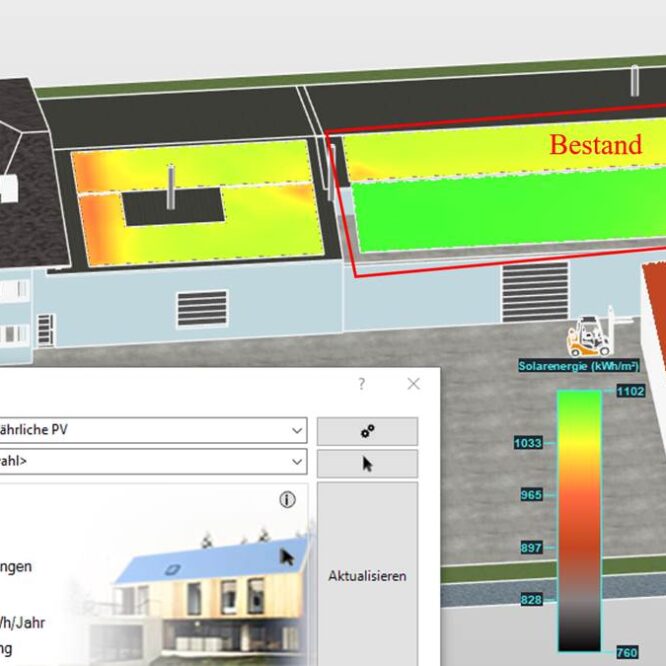In this hydrogen production model, the full potential of rooftop photovoltaic (PV) systems is utilized to maximize energy generation and reduce hydrogen production cost. Lithium battery storage is exclusively reserved for the internal electricity needs of the industrial facility and is not involved in hydrogen production. This clear separation between power supply and hydrogen generation enables efficient energy management while maintaining industrial energy independence. By using PV surplus during peak solar hours, the system supports low-cost hydrogen generation, making it both sustainable and economically viable.
A key element in lowering hydrogen production costs is the integration of large-scale, cost-efficient PEM electrolyzers from Erreduegas, an Italian manufacturer with over 20 years of experience in producing compact, reliable gas generators for industrial applications. Erreduegas electrolyzers stand out in the European market for their affordability, with a cost of approximately €16.5 per normal liter of hydrogen production capacity—one of the most competitive rates available. The company also provides remote diagnostics and support, although maintenance contracts outside of Italy may not always be economically viable.
This setup—optimized PV utilization, low-cost electrolysis, and dedicated lithium storage—forms a robust foundation for cost-effective hydrogen generation. By strategically separating power and hydrogen applications, the system ensures lower hydrogen production costs, higher self-consumption, and better adaptability to dynamic energy markets and industrial demands.
Contents
90 kW electrolyzer with Hydrogen Production Cost and no battery. 1
Hydrogen Production Cost: Optimizing Photovoltaic Potential for Efficient Hydrogen Generation. 1
Reducing Hydrogen Production Costs with Storage Systems 1
Electrolyzer operation and external water treatment costs 1
Hydrogen Production Cost: Compressor for Efficient Hydrogen Compression. 1
Hydrogen Storage Cost: Cylinders and Their Impact on Production. 2
Reducing Hydrogen Production Cost with PV Surplus and Electrolysis in a Dynamic Market 2
Hydrogen Marketing: Sold as Technical Gas and the Value Chain. 3
Conclusion for best Hydrogen Production Cost Solution. 4
Hydrogen Production Cost: Optimizing Photovoltaic Potential for Efficient Hydrogen Generation
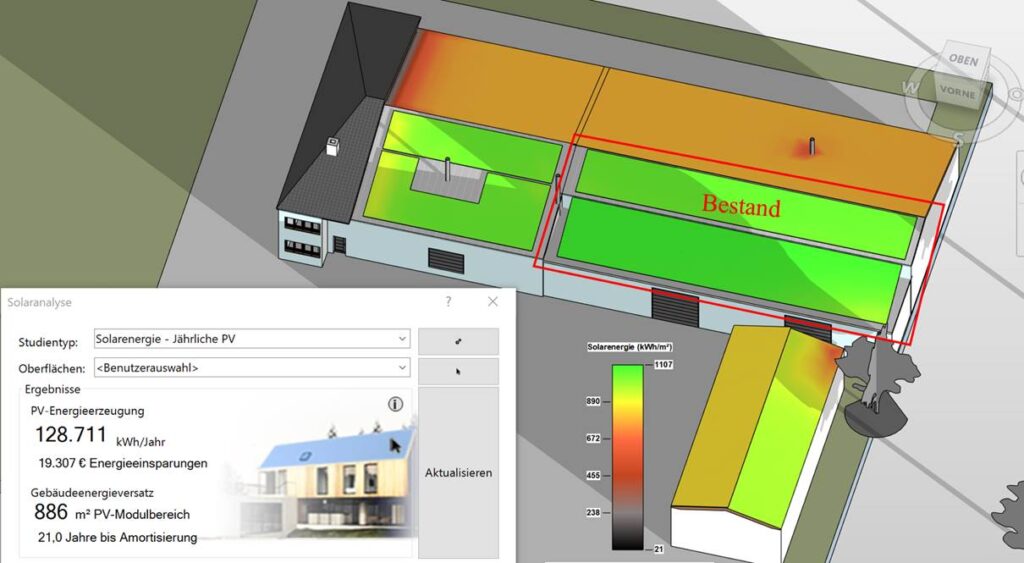
Illustration 1 Photovoltaic potential on the roof surfaces can be fully utilized in this variant. The peak power is less critical, as it rarely reaches maximum levels on north-facing roofs. Even with elevated photovoltaic modules, self-shading is likely to occur, impacting overall efficiency.
Reducing Hydrogen Production Costs with Storage Systems
The industry’s average daily electricity demand is 57 kWh.
A 60-kWh lithium storage system should be a good choice; however, it is not included in the cost calculations here.
Electrolyzer operation and external water treatment costs
| Model | Sirio 2000 |
| H2 Flow Rate(NL/hr)/(kg/100km) | 20000 |
| Price € net | 324.900 € |
| Price / Nl/hr €/W | €16.5 |
The costs for external water treatment, amounting to €8500, are included in the calculations.
Hydrogen Production Cost: Compressor for Efficient Hydrogen Compression
The 4-cylinder compressor plays a crucial role in hydrogen production, as it is responsible for compressing hydrogen for storage or utilization. However, the oil-lubricated compressor is only suitable for combustion engines, limiting its use in other applications.
In terms of hydrogen production cost, this compressor offers an affordable solution, but it requires careful consideration, as the low price and feasibility were based on preliminary consultations. Since most consultants specialize in natural gas compressors, there is limited specific information available for hydrogen-compatible models.
Further evaluation of hydrogen-specific compressors may be required to ensure both efficiency and compliance with hydrogen production standards. This could influence the overall hydrogen production cost due to variations in compressor types and their performance efficiency.
| 0,08988 | |
| Model | V 215/300 NG4 |
| H2 Flow Rate(NL/hr)/(kg/100km) | 21500 |
| Price € net | 41.000 € |
| Price / Nl/hr €/W | 1,91 € |
Hydrogen Storage Cost: Cylinders and Their Impact on Production
On average, 20 Nm³ of hydrogen is produced daily over 8 hours, which equates to 500 liters at 300 bar. This production results in 25 bundles of 12 bottles each, with each bundle priced at €10,000 per month.
If the gas is collected twice a month, approximately 12 bundles will be required for storage. The cost of these cylinders plays a significant role in the overall hydrogen production cost, and careful management of storage capacity can help optimize costs while meeting hydrogen storage needs.
Considering the hydrogen production cost, proper cylinder management and periodic collection are essential to maintaining efficient storage and reducing associated expenses.
Reducing Hydrogen Production Cost with PV Surplus and Electrolysis in a Dynamic Market
This variant optimizes the use of photovoltaic surpluses, with a 1:2 ratio of PV peak power to electrolyzer power.
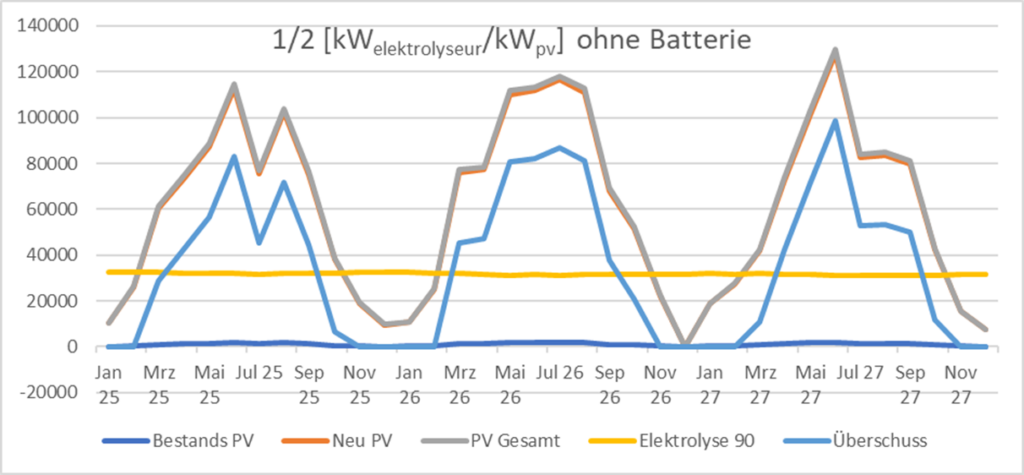
Illustration 1 Degree of utilization of photovoltaic electricity with 90 kW electrolysis and 180 kW peak power
This setup is only viable if hydrogen can be sold to the industry year-round or dynamically traded on the spot market. A smaller electrolyzer could be used for the same approach, though it would cost two to three times more per unit of split hydrogen.
The 90 kW PEM electrolyzer, along with a hydrogen compressor, low-pressure storage, and 12 bundles, is estimated to cost €531,000. Nearly 48% of the surplus electricity can be utilized. The €23,062 in feed-in tariffs, at 7 c/kWh, could further improve amortization.
This setup highlights the importance of efficient hydrogen production and the economic viability of dynamically trading hydrogen on the market to optimize costs and returns.
Hydrogen Marketing: Sold as Technical Gas and the Value Chain
Hydrogen, when sold as technical gas, can command up to €3/kWh on the market. Ideally, the hydrogen value chain should be agreed upon contractually before the start of the project to ensure smooth operations.
A substantial portion of this €3/kWh price is allocated to the gas cylinder industry. This includes various aspects such as gas cylinder sales (renting or buying), transportation, storage, and refilling. To better understand the costs associated with marketing hydrogen in gas cylinders, I reached out to Gase Partner in Witten, and the following insights were gathered:
Purchase Gas 16 bundle from Tyczka H2 3.0 300 bar
€ €/kg Kwh
400,0 25,03268 0,7585661
It was revealed that the gas wholesaler’s margin is four times the value of the hydrogen itself. The consumer prices for hydrogen from 2021 to 2025, based on internal records, are also illustrated in the accompanying graph.

Illustration 2 Hydrogen Price Statistics for Technical Gas in Pressure Vessels
By 2025, hydrogen will be traded in compressed gas cylinders at a minimum price of €4/kWh.
| l | €/kg 2025 | €/kWh |
| 10 | 727 | 22,02 |
| 50 | 172 | 5,22 |
| 600 | 158 | 4,79 |
| 50 | 173 | 5,23 |
| 600 | 145 | 4,40 |
In addition to Gase Partner, hydrogen end customers such as Bayer in Wuppertal or Zinq in Westphalia can also be approached for hydrogen sales.
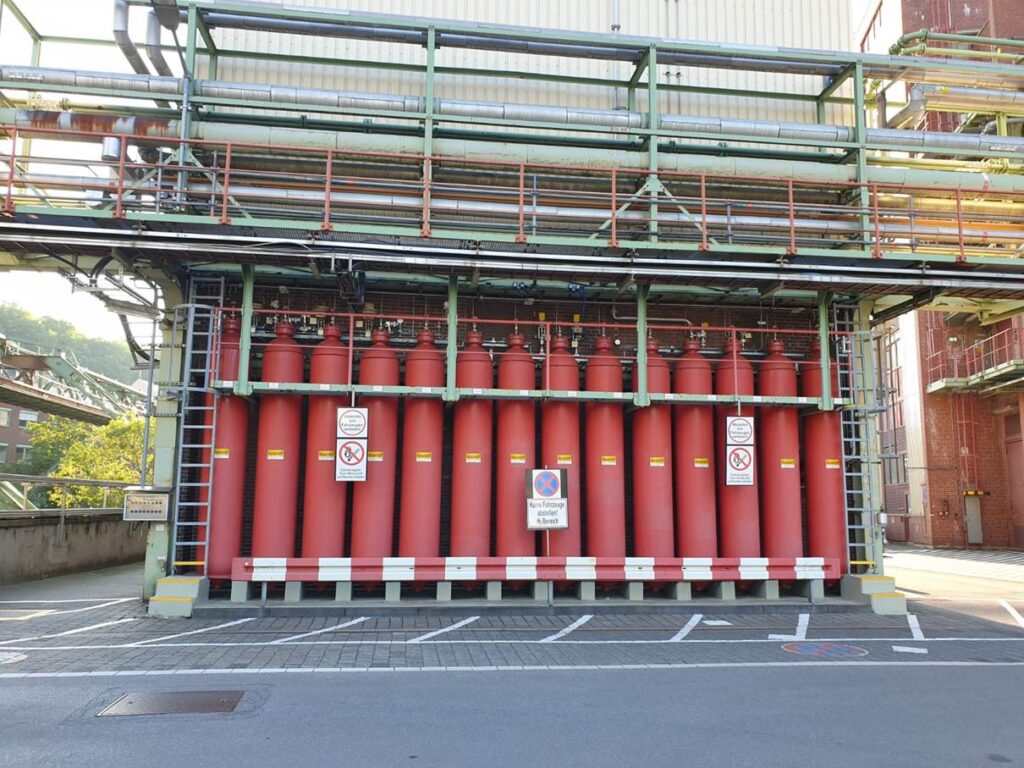
Illustration 3 Hydrogen storage Bayer Wuppertal
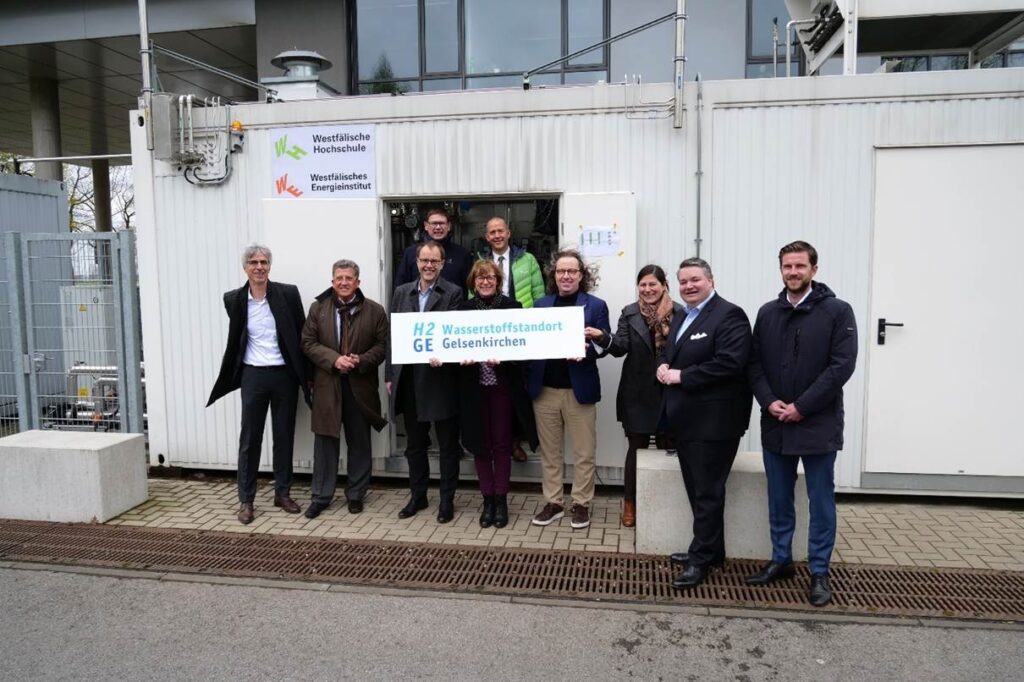
Illustration 4 https://www.zinq.com/aktuelles/2022/mit-wasserstoff-zur-gruenen-industriestadt/
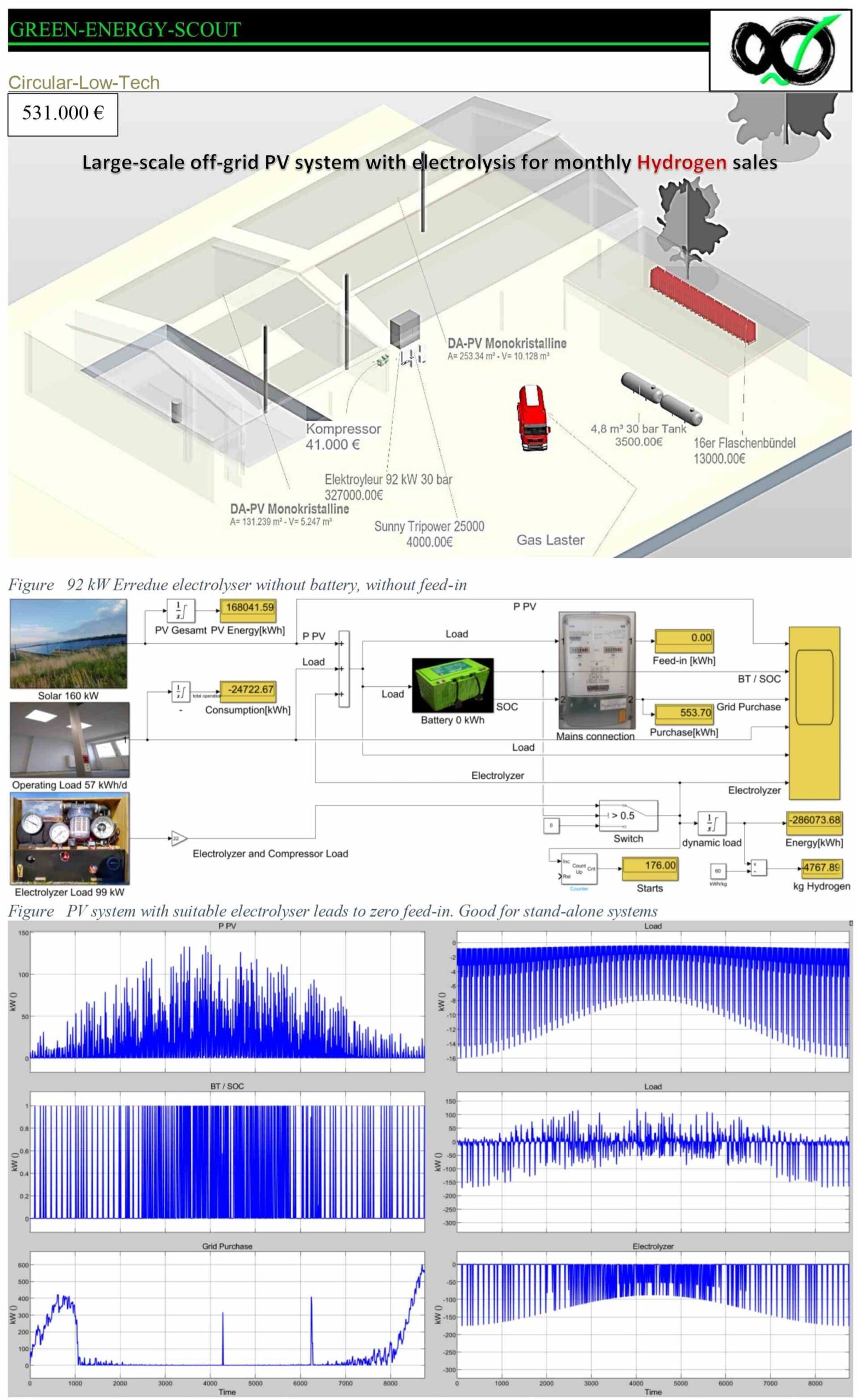
Conclusion for best Hydrogen Production Cost Solution
This hydrogen production model showcases a cost-focused approach by strategically utilizing rooftop photovoltaic potential while forgoing battery integration for hydrogen generation. By channeling surplus solar energy directly into a high-capacity 90 kW PEM electrolyzer, the system maximizes hydrogen output during peak generation periods, making it particularly suited for industrial environments with year-round hydrogen demand or dynamic market trading opportunities.
The use of affordable electrolysis technology from Erreduegas and a cost-efficient compressor solution demonstrates a strong emphasis on minimizing capital expenditures. However, the oil-lubricated compressor’s limited application scope and the need for hydrogen-specific alternatives highlight a key area for further optimization. Moreover, hydrogen storage through gas cylinders remains a significant cost factor, reinforcing the importance of efficient storage management and planned gas collection schedules.
While this model excludes battery storage from hydrogen operations, it maintains industrial energy independence and operational clarity by allocating battery use solely for internal electricity needs. This separation ensures streamlined system performance and reduces complexity.
With a total estimated infrastructure cost of €531,000 and the potential to earn €23,062 annually through feed-in tariffs, the model proves economically promising—especially when coupled with contractual agreements for hydrogen sales. The potential to sell hydrogen as technical gas at up to €3/kWh further boosts the return on investment, though a large share of this revenue is absorbed by storage and transportation logistics within the hydrogen value chain.
In summary, this variant presents a scalable, solar-powered, and economically efficient pathway to hydrogen production—ideal for businesses targeting technical gas markets or engaging in flexible trading scenarios, while also offering insights into areas for further refinement in storage and compression technologies.
